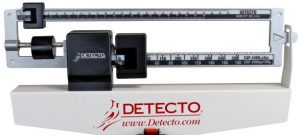One of the questions that folks ask from time to time is how to read a medical scale? Now we are guessing that they are referring to the old mechanical physicians office scales that everybody used to use back in the day. Remember those? They had no digital display. They had a beam that ran across with sliding weights.
So if you’re curious how to read a medical scale weight beam? The way to do it is below.
First, make an educated guess as to approximately what you think the patient will weigh. The reason you do this is because you need to slide the large weight on the beam into the appropriate slot. Then, once you do this, you can fine tune the balance beam using the smaller sliding weight.
So, for example, let’s say a 212 pound patient steps up to the scale. You look at the person and estimate they will weigh around 200 pounds. So you slide the large weight, also known as the large poise, to 200 lb. Then, you slide the small weight, also known as the small poise, which will allow you to fine tune until you get to the correct weight with the beam pointer perfectly balanced. You then add up the 200 lb + the 12 lb fine tuning for the total of 212 lb.
Advantages & Disadvantages of a Mechanical Beam Physician’s Scale
The advantages of a mechanical scale like this is longevity. The disadvantage is that it requires some effort and basic math to obtain a patient’s weight.
Compare this to a digital doctor’s office scale which simply requires a person to stand on the scale and read the weight.
A medical scale is a device used to measure weight. To use a medical scale, you need to follow these steps. Place the scale on a flat, stable surface. Stand on the scale with bare feet, making sure that your weight is evenly distributed. Look at the scale’s display to see your weight. If the scale has a height rod, stand with your back against the rod and look at the display to see your height.
If the scale has additional features, such as body mass index (BMI) or body fat percentage, follow the instructions provided to use those features. When you’re finished using the scale, you’ll want to turn it off to conserve battery life since many of these scales don’t come with the AC Adapter (it’s an option).
Hopefully after reading this, you understand better how to read a medical scale. It’s a good idea to buy high quality reliable medical weighing equipment. And, on a related note, it’s a good idea to have your medical scales tested at least a couple of times a year by a reputable scale company in your area. If you’re having trouble reading the scale, make sure you’re patients are standing still and that the scale is on a level surface. If you’re still having trouble, try consulting the scale’s instruction manual or contacting the manufacturer for assistance.
